The Economics and Statistics Division maintains archives of previous publications for accountability purposes, but makes no updates to keep these documents current with the latest data revisions from Statistics Canada. As a result, information in older documents may not be accurate. Please exercise caution when referring to older documents. For the latest information and historical data, please contact the individual listed to the right.
<--- Return to Archive
For additional information relating to this article, please contact:
April 29, 2022ONTARIO BUDGET 2022-23 Ontario released its 2022-23 Budget on April 28 - the last of Canada's Provincial Budgets. Ontario's budget deficit for 2022-23 is projected to be $18.9 billion, up from a forecast of a $13.5 billion deficit for 2021-22. Ontario is expected to remain in deficit for each the following two fiscal years. By 2024-25, Ontario's deficit is projected to decline to $6.1 billion. The decline in deficit projected over the fiscal plan is mostly attributable to rising revenues. Between 2022-23 and 2024-25, Ontario's revenues are projected to rise by 4.6% per year while expenditures grow by 1.1% over the same period.
Ontario's fiscal plan incorporates contingency amounts to allow for variations in economic performance: $1.0 billion in 2022-23 and $1.5 billion in each of the next two fiscal years. There are at least $4.6 billion in expenditures contingencies in each of the next three fiscal years.
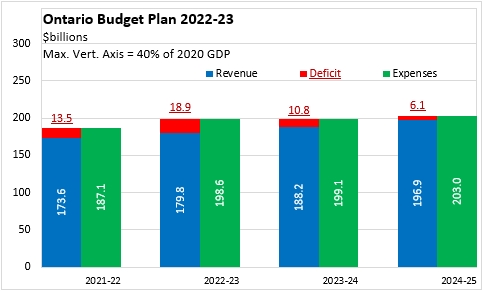
Ontario's fiscal plan has been significantly altered since the 2021-22 Budget estimates. Revenues grew rather than contracting in 2020-21 and came in $13.1 billion higher than estimated. Expenditures in 2020-21 were $9.0 billion lower than estimated. Revenues are projected to continue rising steadily in the current and subsequent fiscal years. Rather than contracting and stabilizing, Ontario's provincial expenditures are projected to accelerated in 2022-23 before their growth slows in the next two fiscal years.
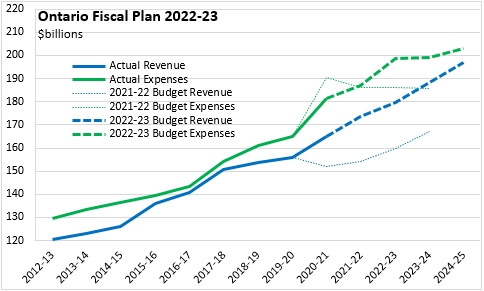
With significant out-performance in revenues, Ontario's deficit projections have narrowed considerably - including a $22 billion improvement in 2020-21. However, higher expenditures in 2022-23 are estimated to widen the deficit to $18.9 billion for this fiscal year. Although deficits are slated to shrink in the next two fiscal years. Ontario's Budget is not expected to return to balance in the current planning horizon.
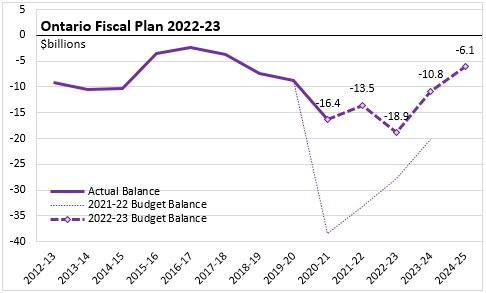
Ontario's deficit is projected at 1.8% of GDP for 2022-23. Subsequent deficits decline as a share of GDP, falling to 1.0% in 2023-24 and 0.5% in 2024-25. The footprint of the provincial government in the Ontario economy is projected to decline from 19.2% of GDP in 2022-23 to 17.9% in 2024-25.
Ontario's net debt to GDP ratio is projected to peak at 41.4% in 2022-23 and 2023-24 before falling slightly to 41.3% of GDP in 2024-25.
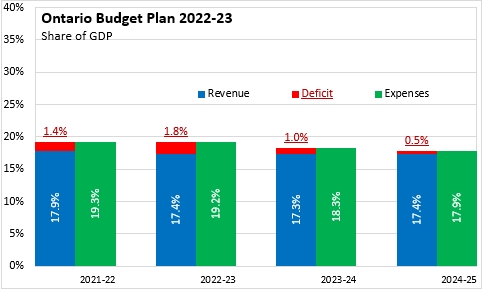
Ontario's current Budget estimates expenditures amounting to just under $13,127 per capita, supported by $11,885 in per capita revenues and a deficit projected to be $1,249 per capita.
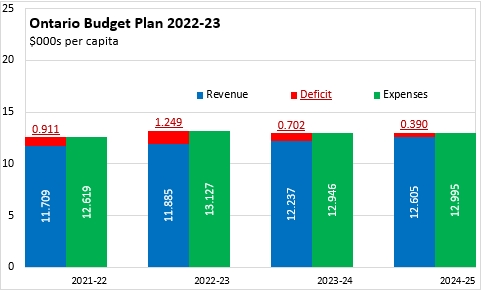
Ontario's economy has faced one of the larger shocks as a result of the COVID-19 outbreak and efforts to contain it. Real GDP is estimated to have declined by 5.7% in 2020 (-4.8% in nominal terms). As of February, employment was still 4.1% below pre-pandemic levels. Ontario's economy is projected to rebound with real GDP growth of 4.0% in 2021, 4.3% in 2022, 2.5% in 2023 and 2.0% in 2024.
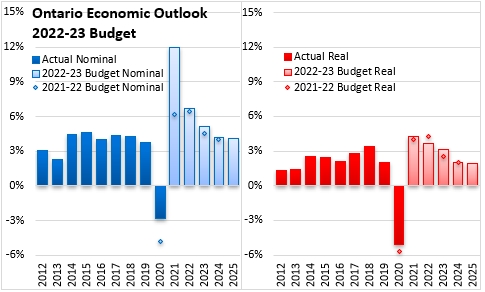
Key Measures and Initiatives
Ontario's Budget emphasizes plans to build, support workers, reduce costs and sustain health care, including:
- Year-round roads in Northern Ontario to access the "Ring of Fire" mineral deposits and connect northern communities to the road grid
- $4 billion to ensure high speed internet in every community by the end of 2025
- $1.4 billion in skills, training and immigration programs
- A capital plan with $158.8 billion worth of investments over 10 years ($20 billion in 2022-23), including $25.1 billion for highway projects, $61.6 billion for public transit, $40 billion in health care and $14 billion in grants to build schools and child care facilities
- Speeding development approvals for housing
- Cutting 5.7 cents from the gasoline tax (from July 1 to December 31)
- Enhancing the Low-income Individuals and Families Tax Credit
- Learn to Stay Grants for graduates of priority health programs such as nursing and work in underserved communities after graduation
- Nursing retention incentive of up to $5,000 per person
- Expansion of 455 post-secondary positions including new medical schools in Brampton and Scarborough
- Investments in Ontario-made personal/protective equipment, therapeutics, medical technologies
Ontario Budget 2022-23
<--- Return to Archive